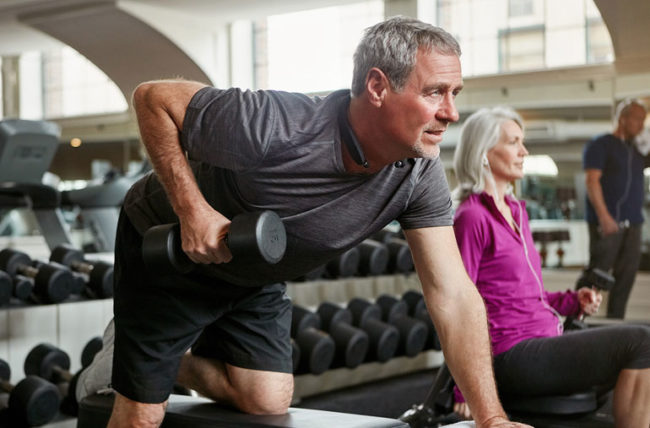
William Farrell knows a thing or two about lifting weights.
In 2011, at the age of 65, Farrell set the world powerlifting records for the 220-pound class of the 65-69 age group in several categories, including squat (308 pounds) and deadlift (399 pounds).
But according to Farrell, you don’t need to be a champion weightlifter to realize the benefits of strength training.
“In terms of strength training, it’s really important after age 50, because you lose muscle mass and it decreases every year, and increasing that through strength training is very important – particularly when you’re older,” Farrell said.
In addition to improving muscle mass, Farrell said that strength training helps strengthen bones.
“A combination of strength resistance training as well as balance exercises really reduces the risk of broken bones,” Farrell said. “The weight you put on your bones prevents osteoporosis. It reverses the natural tendency to get thinning bones as you get older.”
Aydan Crandall, a physical therapist at The RehabGYM in Williston, explained that bone strengthening follows a similar principle as the building and strengthening of human muscle.
“The more force you put on bone, it responds and grows thicker,” Crandall said. “Your muscles all attach to bone, and by putting a load on the muscle, the bone, where the muscle attaches, also strengthens.”
Crandall added that strength training can improve one’s overall balance.
“Strength training tends to lead to better balance. Your muscles can more quickly respond to a loss of balance and correct it,” said Crandall. “All of our physical capacities are a use-it-or-lose-it kind of thing.”
A lack of balance can lead to falls, which Farrell said are of particular concern to older women, whose bone density diminishes dramatically after menopause.
“The chances of a woman dying within five years after fracturing her hip are more likely than those who have a breast cancer diagnosis,” Farrell said.
Besides improving the health and functionality of bones and muscles, Farrell said exercise and strength training can improve the quality of life of those suffering from diabetes or Alzheimer’s disease.
“For a diabetic – particularly for an older diabetic – a combination of strength resistance training and aerobics gives them optimum functioning in dealing with their diabetes and blood sugar levels,” Farrell said. “For Alzheimer’s, regular exercise can help preserve brain volumes.”
But even for individuals not suffering from a serious medical condition, Farrell said that exercise can improve one’s overall health.
“Exercise boosts the immune system,” Farrell said. “There’s a chemical balance between growth and decay, and exercise helps overwhelm the signals the body and brain have toward atrophy.”
Crandall summarized the benefits of strength training by suggesting that it improves one’s general quality of life.
“(Strength training) gives you more ability to do things. You’re not going to get injured getting the groceries or the bag of cat litter out of the car,” Crandall said. “You maintain function, you’re less likely to get injured and you’re going to have a better recovery if you do get injured. So you’re stronger, you have better balance and you have better bone density.”
Exercise Suggestions
Farrell, in his soon-to-be published book, Strong Brains, Strong Bodies: You Can Live Longer, Healthier and Happier, provides simple exercise suggestions for seniors or anyone not in optimal physical condition.
The following excerpts from Farrell’s chapter on exercise and strength training are used by permission of the author:
When your bones are stressed they react to this by increasing their mass. Weight-bearing exercise is essential to maximize your bone density. Climbing stairs, walking or jogging are examples of exercises recommended at least 5 times per week. Performing resistance or weight training exercises 3 times per week for 30 minutes per session is recommended.
Strength training can be accomplished even without the use of weights or equipment. Push-ups can be done in your bedroom or living room and even if you aren’t strong enough to do a full standard push-up you can start by doing easier modified push-ups by dropping to your knees instead of staying on your toes. As you increase your strength, work toward doing full push-ups for 3 or 4 sets of 10 to 12 repetitions.
To increase the strength in your upper arm biceps place 2 sturdy chairs 3 feet apart and place a sturdy broom handle or other strong pole across them. Lie on your back and pull yourself up to your upper chest. Try to do 5 repetitions. As you get stronger you may be able to do 10 repetitions for 3 or 4 sets.
To increase your core strength you can do side-lying leg lifts. Here you lie on your side with one leg resting on top of the other. Lift your leg slowly and keep it in line with the body. Do 10 repetitions and turn over and do the other side. As you get stronger you can increase the repetitions.
For your legs, sit in front of a solid chair and stand up without assistance from your hands. Then, slowly lower yourself back to a sitting position and only use your hands if necessary. This exercise is good for your thighs. Try to do 10 repetitions. As with the other exercises as you get stronger you can do more repetitions and 3 or 4 sets of the exercise.
For your lower legs you can do heel raises. Stand in front of the bathroom or kitchen counter without leaning on it and raise up on your toes with both feet as high as you can manage. Hold it for 2 or 3 seconds. Try to do 10 to 20 repetitions. When you become stronger you can try to do 1 foot at a time.
This article was contributed by Luke Baynes.
 Related Articles & Free Subscription
Related Articles & Free Subscription
10 Benefits of Weightlifting for Age-Related Muscle Loss for Seniors




Comment here